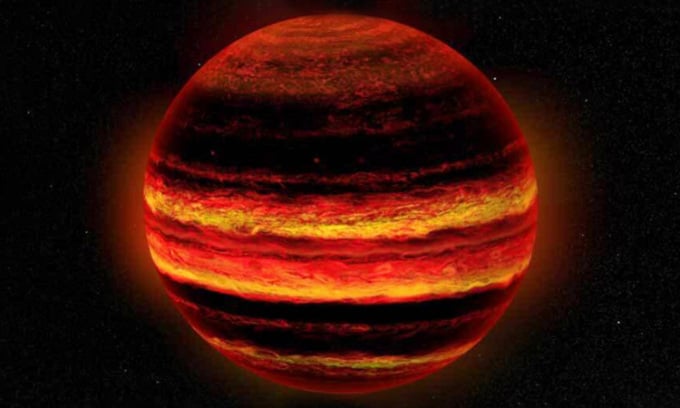Astronomers have found an unusually hot brown dwarf orbiting a star about 1,400 light-years from Earth.

Illustration of a brown dwarf. Photo: NASA Goddard Space Flight Center
According to research posted on the arXiv database and scheduled to be published in the journal Nature Astronomy , the newly discovered brown dwarf has a temperature of about 7,730 degrees Celsius, while the surface temperature of the Sun is only about 5,500 degrees Celsius, Newsweek reported on June 20. An international team of experts led by astrophysicist Na'ama Hallakoun at the Weizmann Institute of Science, Israel, named this celestial body WD0032-317B.
Brown dwarfs are part star, part planet, sometimes called "failed stars." They are giant balls of gas, typically 13 to 80 times the mass of Jupiter, that do not yet have enough mass to sustain the nuclear fusion process necessary to become a true star like the Sun.
Brown dwarfs are typically much cooler than WD0032-317B, which makes it the hottest brown dwarf ever recorded. Brown dwarfs typically have temperatures of 480 - 1,930 degrees Celsius because they don't produce as much energy as a real star. WD0032-317B has a mass 75 - 88 times that of Jupiter and orbits its star in just 2.3 hours.
WD0032-317B is unusually hot because it orbits so close to its star and is exposed to a high level of ultraviolet light. This can lead to pyrolysis, which vaporizes the orbiting body’s atmosphere and tears away molecules. Another example of a body that orbits so close to its star that pyrolysis occurs is KELT-9b, a gas giant exoplanet with a surface temperature of about 4,430 degrees Celsius on the side facing the star.
The team hopes the new findings will help them understand conditions on gas giant planets like Jupiter, such as KELT-9b, which orbit near super-hot, massive stars. Observing these planets is difficult because they are so close to their host stars.
Thu Thao (According to Newsweek )
Source link



![[Photo] A brief moment of rest for the rescue force of the Vietnam People's Army](https://vstatic.vietnam.vn/vietnam/resource/IMAGE/2025/4/3/a2c91fa05dc04293a4b64cfd27ed4dbe)
![[Photo] Prime Minister Pham Minh Chinh chairs the first meeting of the Steering Committee on Regional and International Financial Centers](https://vstatic.vietnam.vn/vietnam/resource/IMAGE/2025/4/3/47dc687989d4479d95a1dce4466edd32)
![[Photo] Prime Minister Pham Minh Chinh chairs meeting after US announces reciprocal tariffs](https://vstatic.vietnam.vn/vietnam/resource/IMAGE/2025/4/3/ee90a2786c0a45d7868de039cef4a712)
![[Photo] Ho Chi Minh City speeds up sidewalk repair work before April 30 holiday](https://vstatic.vietnam.vn/vietnam/resource/IMAGE/2025/4/3/17f78833a36f4ba5a9bae215703da710)
![[Photo] Capital's youth enthusiastically practice firefighting and water rescue skills](https://vstatic.vietnam.vn/vietnam/resource/IMAGE/2025/4/3/3f8481675271488abc7b9422a9357ada)
![[Podcast] News on March 24, 2025](https://vstatic.vietnam.vn/vietnam/resource/IMAGE/2025/4/3/f5fa1c3a9ae14d4590ac6965d233586b)

![[Podcast] News on March 25, 2025](https://vstatic.vietnam.vn/vietnam/resource/IMAGE/2025/4/3/735b3003484942af8e83cbb3041a6c0c)
![[Podcast] News on March 26, 2025](https://vstatic.vietnam.vn/vietnam/resource/IMAGE/2025/4/3/c3d9c3c48b624fd9af79c13ff9e5c97a)
![[Podcast] News on March 27, 2025](https://vstatic.vietnam.vn/vietnam/resource/IMAGE/2025/4/2/de589137cda7441eb0e41ee218b477e8)
![[Podcast] News April 2, 2025](https://vstatic.vietnam.vn/vietnam/resource/IMAGE/2025/4/2/eaa5bcbdb47a439bb7c43a417033535c)
![[Podcast] News April 1, 2025](https://vstatic.vietnam.vn/vietnam/resource/IMAGE/2025/4/2/bba48391b1ad42a5b4603dbfded20f5d)

![[Video] Eliminate the "can't do it, ban it" mindset in science](https://vstatic.vietnam.vn/vietnam/resource/IMAGE/2025/4/3/1122c1ea9e244ddab1331a0597c60638)














































































Comment (0)